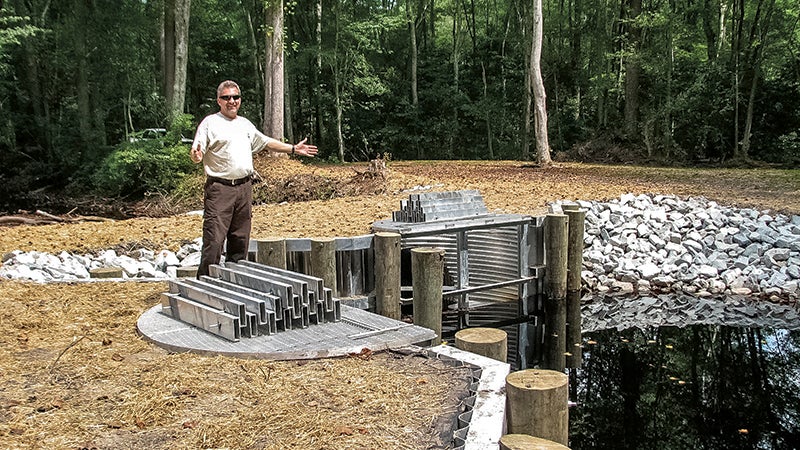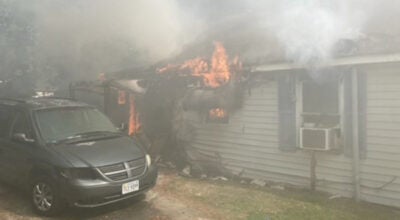Re-watering the swamp
Published 3:30 pm Monday, September 5, 2016

- Great Dismal Swamp National Wildlife Refuge manager Chris Lowie shows off water control structures at the intersection of Portsmouth and Hardwood ditches in the refuge.
$3M swamp project aims to control water
Deep in the Great Dismal Swamp, construction is under way for a project that has the potential to affect millions of people in a positive way — and they’ll likely never know that it did.
The $3.13-million project aims to install, repair or replace 12 water control structures in ditches in the northeast quadrant of the refuge.
“We’re trying to increase the resiliency of the swamp by re-watering it,” refuge manager Chris Lowie said recently on a tour of the project.
The massive water control structures include adjustable dams and culverts. Once complete, the water control structures will be able to direct water and keep it in the refuge longer.
The impacts are multi-faceted and affect communities both local and worldwide.
On a hyper-local scale, the Deep Creek community of Chesapeake will be seeing less flooding if water stays on the swamp for a longer period of time.
Regionally, a wetter swamp means less risk of wildfire, Lowie said. A swamp that has somewhat returned to its natural state also supports an ecologically diverse habitat.
And worldwide, wetter soil and less wildfire means less carbon emission from the peat soil.
“By re-wetting the swamp, we become a sink, rather than a source of carbon,” Lowie said.
The project was funded by the Hurricane Sandy Disaster Relief Appropriations Act of 2013. During the Sandy disaster, the nation saw the effects on communities that were insulated — or not — by well-managed natural areas like the Great Dismal Swamp.
The refuge consists of about 112,000 acres of forested wetlands, and the project spans about 30,000 acres.
Prior to the refuge’s establishment in 1974, the swamp was heavily modified with ditches, roads and a canal for agricultural purposes, including the harvesting of timber.
Coupled with growing urban development surrounding the refuge, the modifications have taken a toll on the area’s natural hydrology. Rather than the relatively slow and diffuse overland and groundwater flow across long distances that existed in pre-development conditions, water now collects and drains rapidly through the extensive ditch network.
As a result, peat soils no longer hold the ground and surface waters necessary to keep them wet, leaving the landscape drier and more susceptible to wildfire. At the same time, flooding occurs more frequently in adjacent communities during heavy rains.
In 2008 and 2011, two major lightning-caused fires ripped through the refuge, costing more than $20 million to suppress and emitting an estimated four million metric tons of carbon, according to the U.S. Fish and Wildlife Service.
“There are 1.5 million people living within an hour from the refuge that can be affected by our wildfires,” Lowie stated in a press release. “People were smelling the smoke all the way up in Philadelphia and Washington, D.C.”
Tropical storms have affected the refuge, too. In 1999, Hurricane Floyd resulted in overflow of the swamp canal, which created water quality issues for Chesapeake’s drinking supply. In 2003, Hurricane Isabel caused extreme road flooding and blew down rare forest communities at the refuge, which later contributed to several wildfires.
Hurricanes Irene and Sandy both dropped high amounts of rain in a short period of time, resulting in flooding to nearby communities and farms. Irene’s rainfall also helped extinguish one of the wildfires.
Lowie said the project currently being undertaken at the refuge aims to solve these problems.
“We’re trying to slow the drainage,” he said. “We’re trying to increase the ‘residency’ of water on the swamp.”
Quality Enterprise is completing the work, and Lowie said they hope to be done by the end of March.
A number of devices are in place to measure how the project works. Chesapeake has been collecting flood data and will continue to do so post-completion, Lowie said. Devices on the refuge also will measure the height of ground and surface water before and after completion.
“It’s going to be a tough analysis,” Lowie said, noting it all depends on how much rain falls. “But we’re really excited.”






